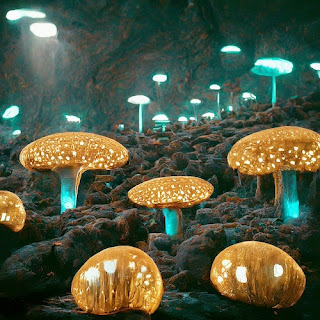Algerian Subterranean Mushroom Farm
Algerian Subterranean Mushroom Farm
Imagine delving deep beneath the Atlas Mountains, not into darkness, but into a world illuminated by the soft glow of a subterranean mushroom farm. Here, nestled within the cool embrace of the earth, thrives a futuristic marvel of sustainable agriculture.
Plan and Materials:
Cavern Selection: Geologists meticulously choose a stable and spacious cavern within the Atlas Mountains, ensuring structural integrity and suitable temperature/humidity conditions.
Climate Control: An intricate network of sensors, ventilation systems, and climate control units maintains the ideal temperature and humidity for optimal mushroom growth.
Growing Medium: A combination of sterilised straw, wood-chips, and other organic materials provides a nutrient-rich substrate for the mushrooms.
Lighting Systems: Customisable LED panels emit specific light spectrums to stimulate growth and fruiting in different mushroom varieties.
Types of Mushrooms:
- Gourmet varieties: Shiitake, Oyster, Maitake, King Oyster, Chanterelle (cultivated strains).
- Medicinal varieties: Reishi, Lions Mane, Cordyceps (grown under controlled conditions).
Future Technologies and Systems:
- Automated Systems: Robots handle tasks like spawning (planting), misting, harvesting, and packaging, ensuring efficient and contamination-free production.
- Environmental Monitoring: Sensors constantly track temperature, humidity, CO2 levels, and other critical parameters, automatically adjusting conditions as needed.
- Vertical Farming Techniques: Stacked growing beds maximise space utilisation, allowing for a high yield within the cavern.
Instruction and Method:
- Site Selection and Preparation: Geologists identify and prepare a suitable cavern, ensuring structural integrity and safety.
- Climate Control Installation: A comprehensive network of sensors, ventilation systems, and climate control units are installed throughout the cavern.
- Substrate Preparation: Organic materials like straw and wood-chips are sterilised and spread across designated growing areas within the cavern.
- Mushroom Spawn Introduction: Specialised mushroom spawn (inoculum) is introduced onto the prepared substrate to initiate fungal growth.
- Automated Systems Integration: Automated systems for misting, harvesting, and environmental monitoring are implemented and programmed for optimal efficiency.
Problems and Solutions:
- Maintaining Ideal Conditions: The automated climate control system continuously monitors and adjusts factors like temperature, humidity, and CO2 levels to combat potential fluctuations.
- Pest and Disease Control: Strict sterilisation protocols and environmental controls minimise the risk of contamination, while beneficial microorganisms can be introduced to combat potential pathogens.
- Limited Waste Management: Organic waste from harvested mushrooms is composted within the cavern, creating nutrient-rich fertiliser for future crops.
Future Benefits:
- Sustainable Food Production: The farm provides a reliable source of nutritious and delicious mushrooms year-round, reducing reliance on traditional agriculture and its environmental impact.
- Medicinal Applications: Cultivating medicinal mushroom varieties provides valuable resources for the pharmaceutical industry, contributing to advancements in health and wellness.
- Job Creation: The farm creates new job opportunities in areas like biotechnology, engineering, and mushroom cultivation.
Resource Conservation and Biodiversity Tips:
- Utilise renewable energy sources like geothermal power to operate the farm's systems.
- Encourage the growth of native fungi aboveground near the cavern entrance, promoting biodiversity and fostering a connected ecosystem.
- Research and implement techniques for water recycling within the farm to minimise freshwater usage.
DIY Tips for Home Growers:
While building a subterranean mushroom farm might not be feasible at home, you can cultivate delicious and healthy mushrooms with a smaller setup:
- DIY Mushroom Growing Kits: Purchase pre-sterilised substrate kits with specific mushroom varieties for easy at-home cultivation.
- Utilise Recycled Materials: Grow mushrooms in repurposed containers like coffee grounds bags or cardboard boxes.
- Research Local Varieties: Explore the possibility of cultivating native or regionally adapted mushroom species for a truly unique at-home experience.
Algeria's Subterranean Mushroom Farm is a testament to the potential of innovation in creating sustainable food production systems. By embracing these technologies and harnessing the power of nature, we can ensure a future where even the most challenging landscapes can become vibrant centres of life and growth.




